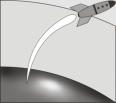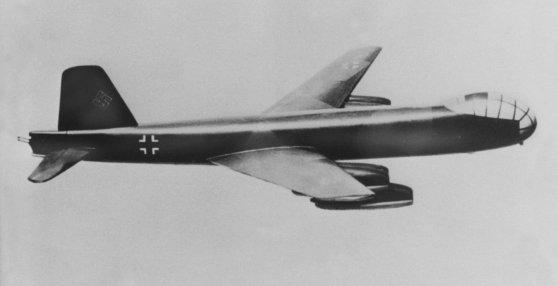

JAP
Jack Aerospace Publishing



A wind tunnel model of the Super-Stuka, the first
Junkers Ju 287.
The Junkers project EF 116 was a twin jet
design with forward swept wings.
The Junkers EF 122 was larger than the
EF 116 and therefore had four jet engines.
Junkers Ju 287 jet bomber with six jet engines
The final design accepted by the Luftwaffe hat a crew of three and six jet engines
in triple clusters under each wing. This bomber and reconnaissance aircraft
received the designation Ju 287. To test the unknown effects of forward swept
wings, two experimental aircraft were build. The fuselage was composed of
Cockpits from the bomber Heinkel He 177 and the tail from Junkers Ju 188 G-2.
The first test aircraft, Ju 287 V1, took off to its maiden flight at August 8th, 1944.


The first experimental aircraft for the swept forward jet bomber:
the Junkers Ju 287 V1. It had four jet engines.
This is what the production Ju 287 jet bomber would have looked like.
A presentation model used by Junkers for marketing purpose.
When the war ended in May 1945, the third prototype for the jet bomber, the
Ju 287 V3 was was not yet completed. It should be the first example of the
production version. US-troops captured the Junkers works at Dessau, but handed
it over to the Russians two month later.
The Russians collected all available members of the Junkers team and started
to build the Ju 287 prototypes again. In October 1946 more than 5000 German
specialists and their families were transported to the Soviet Union, where they
completed the Ju 287 under the designation EF 131. After a few test-flights, the
bomber was converted into the reconnaissance aircraft EF 140.



With two soviet copies of Rolls-Royce jet engines and new wingtip-tanks, the Ju 287
(EF 131) was flown in the USSR as the EF 140 reconnaissance aircraft.
The Junkers jet after the war
The Soviets ordered no series production for the EF 131 (Ju 287) or EF 140. So the
Junkers team designed a new jet bomber as the Type 150 (EF 150). A prototype
was tested, but again no production ordered. When the Germans were allowed to
return home in 1954, the Junkers engineers in East Germany designed the jet
airliner Type 152 based on the Type 150. Protypes where build and flown, but when
the Russians refused to buy airliner from other countries, the project was cancelled.
The only prototype of the Junkers Type 150 flew for the first time at
October 5th, 1952.
In communist East-Germany, the Type 152 was build and tested.
This project was abandoned in 1961 after two aircraft had flown.


The complete Ju 287-Story in one Volume!
More than 9600 words.
More than 100 pictures.
47 pages in print, large format.
Available in various e-book formats.


Text: English plus German
Roll- und Schiebemessungen am
Modell Ju 287
A reprint of a secret report from the German
Research Institute for Aviation (DVL) at Berlin-
Adlershof from February 1945 to the
Reichsluftfahrtministerium (RLM). The report
examines the spinning behavior of a 1:11 scale
model of the Junkers Ju 287 with forward swept
wings in the institute's wind-tunnel. The stall
behavior was also examined with the flow directly
from the front and at small sideward angles.
This unique piece of aviation history comes with
52 pages, diagrams, drawings, and wind-tunnel
photographs from the model examined at the
DVL.
English summery - document-text in German.
Messungen am Modell Ju 287
This publication is a reprint of a secret report
from the Junkers company from August 1944 to
the Reichsluftfahrtministerium (RLM). After the
design of the Junkers Ju 287 changed from two
engines at the fuselage sides plus twin nacelles
under each wing to a triple engine cluster under
the wings, the Junkers design office needs a
forecast of the aircraft's flight characteristics. A
large model of 1:4.5 scale was examined in the
company's wind-tunnel at Dessau.
This reprint comes with 50 pages, lots of
diagrams and drawings of the wind-tunnel
model.
English summery - document-text in German.
Überblick über Auslegung und
Entwicklung des Strahlbombers Ju 287
Reprint of a secret report from the Junkers
company from September 1944 to the Reichs-
luftfahrtministerium (RLM). Junkers reports
technical and military data for the future planning
of the Luftwaffe's bomber force. Six prototypes
and additional test aircraft for components of the
Ju 287 under development are described. A pre-
series of 154 aircraft was planned, followed by
the A-series with BMW 003 engines and the B-
series with Jumo 004 C engines.
24 page reprint pages with tables, diagrams
and three model photographs of how the Ju 287
would have looked in Luftwaffe camouflage.
English summery - document-text in German.

Junkers Ju 287
The most advanced jet-bomber of the Luftwaffe
A short summary
A project was started at Junkers under the designation Ju 287 to find a successor to
the famous Luftwaffe Stuka Ju 87. Aerodynamically refined, this Super Stuka should
be a single seater, have a more powerful engine and a retractable landing gear. After
the project was cancelled because the Focke-Wulf Fw 190 would be used for this
purpose, the number 287 was free for the new jet bomber, Junkers was planning.
Under the project numbers EF 116 (two engines) and EF 122 (four engines),
Junkers tested various designs in its windtunnel. Swept wings wings showed an
improvement in flight performance and topspeed of this aircraft. Swept forward wings
additionally promised the best performance at low speeds and high angles of attack.





Print or Kindle-eBook:
eBooks:
epub mobi pdf lrf pdb txt html:










